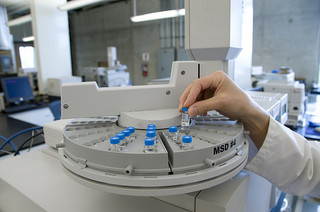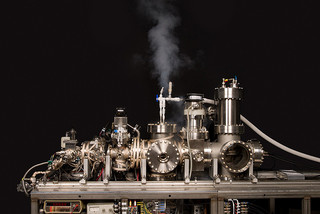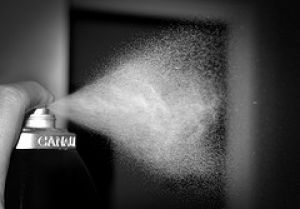
FOLLOW YOUR NOSE: ENGINEERING IN PERFUMES
Follow Your Nose: Engineering in Perfumes
Most people view perfumes as delicate works of art, created with a meticulous hand and applied with a careful touch. However, the introduction of engineering into the analysis and creation of fragrances has mechanized the process more than ever before. The consequences of these new methods, both intended and unintended, have changed the industry irreversibly and provided an insight into the future of all cosmetics.
INTRODUCTION
The everyday routine for most women might be something like this: style your hair, brush your teeth, pick an outfit, and spritz a fragrance on your skin, the last of which happens quickly and without a second thought. However, for some scientists and engineers, perfume-making requires a more careful analysis. Perfumery, once thought of as an art, has been transformed into a scientific process in which natural scents are broken down into constituents and replicated with synthesized materials. Many in the perfume industry benefit from the engineering that makes it possible to replace regulated ingredients and to scientifically determine a fragrance’s quality. But others decry the ease with which companies can now make knock-offs and the death of what was once considered a secret art. The introduction of engineering into perfume-making has permeated nearly every aspect of the industry and will likely continue to change the character of fragrances for years to come.
Angela Android /Wikimedia Commons

age Atomizer Perfume Bottle
A HISTORY OF FRAGRANCE
Various forms of fragrances have existed since 7000 B.C. These initial perfumes were usually made from gums, resins, oils, and plants. The uses went beyond cosmetics – often, perfumes acted as important items in religious ceremonies, funerals, and medical procedures, duties which are a far cry from the role of perfumes today [1]. Gradually, as international trade became more feasible, fragrances of different cultures spread around the world and perfume began seeping into other avenues of society, no longer restricted to religious ceremonies and medical procedures.
The process behind the perfumes we think of today began in the late 19th century, when perfumers diligently studied how to extract scents from flowers. Thus began in earnest the idea of perfumery as an art, an idea that prevails to this day (Fig. 1). Edmond Roudnitska, a French perfumer, compared the practice to making music: “You will have a simple fragrances, simple accords made from one or two items, and it will be like a two- or three- piece band. And then you have a multiple accord put together, and it becomes a big modern orchestra” [2]. Perfumery, on account of its long history and detailed creation process, became a craft for many perfumers. However, engineering is beginning to take a primary role in breaking perfumes down into an exact science.
MEASURING A FEELING
Assessing a perfume’s quality would appear to be a highly subjective process. How can you quantify a fragrance’s musky odor, or its hints of floral character? One of the answers, according to engineers, is in perfume ternary diagrams. Traditionally, a perfume’s notes are broken down into three types: top notes, middle notes, and base notes. Top notes are the strongest flashes of odor that are detected just minutes after application. The middle notes, which remain for hours, are what the odor evolves into after the top notes have gone. The base notes, which serve to stabilize the top and middle notes, can last for days [3].
This information was combined with ternary phase diagrams, which are typically used in engineering and physical chemistry to describe the compositions and components of a substance. The result was the Perfumery Ternary Diagram, which suggests specific percentages for each type of note [4]. A ternary diagram is a triangle-shaped graph in which any point within the triangle provides information about the relative compositions of three components, each of which is represented by a side. In this way, someone could read the diagram and determine exactly how a perfume’s character has been developed.
Scientists have gone even further in breaking down perfume’s components. Four engineers at University of Porto in Portugal noted that this method was too simple, and wanted to include other factors such as distance of the fragrance from the nose, rate of evaporation, and the fact that odors arrive to the nose in bursts, not as a constant stream. Accordingly, the engineers created Perfumery Quaternary Diagrams, which turn the ternary diagram's triangle shape into a tetrahedral, which is a three-dimensional figure with four triangle faces [3]. This allows for an extremely detailed analysis of a perfume’s efficacy and character. Engineers are able to determine the impact of a scent upon application, its ability to travel far distances, and the effectiveness of each fragrance. What was once a subjective determination of quality has become a highly detailed and researched quantifiable inspection of components.
IMPLICATIONS FOR HEALTH AND SAFETY

Wikimedia Commons/Wikimedia Commons
Figure 2: A reverse engineering technique: gas chromatography
The close analysis of fragrances has also made it possible for manufacturers to replace common perfume ingredients. The International Fragrance Association (IFRA) restricts ingredients deemed unsafe or bad for the environment; currently, 174 ingredients have been restricted or banned [5]. These ingredients were used in all six classes of fragrances (floral, oriental, citrus, chypre, green, and fougere) before becoming restricted [6]. Because so many ingredients are now out of reach to perfume makers, manufacturers have been scrambling to replace these components.
Reverse engineering is one solution to this problem. Chemists use techniques such as gas chromatography (Fig. 2) and mass spectrometry (Fig. 3), which allow them to identify some of the constituents in a perfume by measuring the relative time it takes for chemicals to pass through a certain material. After determining some of the molecules that make a fragrance, chemists can then attempt to re-create an odor by either synthesizing a combination of the molecules or finding natural substitutes for the fragrance, both of which are often long trial-and-error processes. Still, there is a degree of precision to the process. Perfumers are no longer hunched over a wooden workbench, pouring liquids from vial to vial. Instead, most of their mixing work is done by computers, which can add exact amounts of ingredients to a solution, making sure not to violate any of the IFRA’s rules [5].

Texas A&M/Flickr
Figure 3: Mass Spectrometer
This automation of perfume creation is undeniably efficient and exact. However, some wonder at the cost of what was considered an art form. British perfumer Roja Dove compared the substitution of key perfume ingredients to “trying to make a chicken dish if you can no longer use chicken.” Fragrance writer Denyse Beaulieu describes new, regulation-following scents as “skinny and fleshless” [5]. In reality, IFRA’s regulations may not be stringent enough. A report by The Campaign for Safe Cosmetics and Environmental Working Group in 2010 revealed that fragrances on average contain 14 chemicals that are not listed on the label, many of which can cause serious health problems. Chemicals are either inhaled or absorbed through the skin when applied, with effects such as allergic reactions, hormone disruption, or even birth defects. The study found that the International Fragrance Association has appraised 22 of 91 ingredients found in fragrances, not nearly enough to fully understand the consequences these perfumes may have on the human body [7]. Had it not been for the scientific analysis of fragrances, these health risks would have gone undetected. The close eye with which these groups watch perfumers is also kept on cosmetics and health product manufacturers, meaning more people are able to discover what exactly they are applying on their bodies every day.
COMPROMISING AUTHENTICITY
The ability to determine the components of a fragrance comes with pitfalls. Companies with basic analytical chemical equipment such as gas chromatographs can analyze scents and attempt to replicate popular fragrances [5]. Since exact chemical compositions cannot be copyrighted, these companies are not engaging in illegal behavior. Reverse engineering makes it possible for heavily researched and developed fragrances to be imitated with minimal effort and quality. David Erikson, a business litigation attorney, explained the process: “All they need to do is have the original (fragrance) chemically analyzed, toss some similar ingredients together and bingo, they are in business.” However, the copy often includes ingredients that may come together to smell similar to the original scent, but without the long-lasting quality of the actual perfume [8]. Chemists analyzed designer and imposter perfumes using gas chromatographs and mass spectrometers and found discrepancies in the molecules used and in their ability to be detected by the nose [9]. Perfume creation was once a secret art, but the ability to reverse engineer and quantify scents has lifted the veil on the fragrances’ recipes, causing the formation of a subset of the industry devoted to knock-offs. For every advancement made by science in the arena of fragrances, there is an unintended consequence that turns the industry on its head.
THE FUTURE OF 123FRAGRANCES.NET

Wikimedia Commons/Wikimedia Commons
There are certainly advancements on the horizon for the fragrance industry. Lucy McRae, a perfume artist in the Netherlands, is working on a pill that, once swallowed, will turn human body sweat into a pleasing scent [10]. The pills would contain lipid molecules similar to fat molecules, and when the body perspires, the lipids would be metabolized and released through the skin as sweat [11]. This plan is not without obstacles – namely, how to make the chemicals last through the digestive process and go into the blood. But the idea of cosmetics in pill form is a rising trend in the beauty industry, and will likely not be halted, barring serious complications. This indicates the direction of the future of the health and cosmetics industry in terms of the use of engineering and the gradual decline of pure artistry. Perfume making has changed irreversibly in the last few decades on account of engineering, with both positive and negative consequences. Though traditionalists disapprove of the transformation of perfume making from an art into a science, they would be in denial if they refused to acknowledge that engineering will only play a larger role in the creation and manufacturing of fragrances in the future.
REFERENCES
- [1] C. Castel et al (2009, June). "Perfumes in Mediterranean antiquity."Flavour and Fragrance Journal[Online]. 24(6), 326-334. Available: http://onlinelibrary.wiley.com.libproxy.usc.edu/doi/10.1002/ffj.1944/abstract
- [2] S. Karpinnen.A View of the World of Perfume[Online]. Available: http://zebra.sc.edu/smell/shannon/shannon.html
- [3] M. Teixeira et al (2009, June). "Perfumery Quaternary Diagrams for Engineering Perfumes."AIChE Journal[Online]. 55(8), 2171-2185. Available: http://onlinelibrary.wiley.com.libproxy.usc.edu/doi/10.1002/aic.11811/abstract
- [4] V. Mata et al (2005, July). "Engineering Perfumes."AIChE Journal[Online]. 51(10), 2834-28552. Available: http://onlinelibrary.wiley.com.libproxy.usc.edu/doi/10.1002/aic.10530/abstract
- [5] C. Humphries. (2011).Engineering Replacements for Essential Perfume Ingredients[Online]. Available: http://www.wired.com/magazine/2011/10/ff_perfume/all/1
- [6] S. Fenton. (2006).Common scents: 6 basic fragrance types[Online]. Available: http://www.bankrate.com/brm/news/advice/20040213b1.asp
- [7] H. Sarantis et al. (2010).Not So Sexy: The Health Risks of Secret Chemicals in Fragrance[Online]. Available: http://www.ewg.org/files/SafeCosmetics_FragranceRpt.pdf
- [8] Law Firm Newswire. (2011).Knockoffs Now Becoming Familiar in Perfume Industry Says Los Angeles Fashion Lawyer[Online]. Available: http://www.lawfirmnewswire.com/2011/02/knockoffs-now-becoming-familiar-in-perfume-industry-says-los-angeles-fashion-lawyer/
- [9] K. Mowery et al (2004, Jan.). "Investigation of Imposter Perfumes Using GC-MS."Journal of Chemical Education[Online]. 81(1), 87-89. Available: http://pubs.acs.org.libproxy.usc.edu/doi/pdf/10.1021/ed081p87
- [10] G. Mohney. (2011). "Pill in the Works to Turn Sweat into Perfume" [Online]. Available: http://abcnews.go.com/Technology/pill-future-turn-sweat-perfume/story?id=14819832#.TytY0OPC4Vk
- [11] B. Verbrugghe. (2011).Swallowable perfume will emit fragrance from the skin[Online]. Available: http://www.springwise.com/lifestyle_leisure/swallowable-perfume-emanate-fragrance/



3 commentaires
What is the best online perfume store?
Which is better FragranceX or 123Fragrance.Net?
Why are fragrances discontinued?